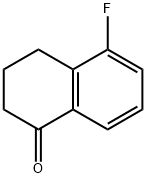
5-Fluoro-1-tetralone synthesis
- Product Name:5-Fluoro-1-tetralone
- CAS Number:93742-85-9
- Molecular formula:C10H9FO
- Molecular Weight:164.18

143654-62-0

93742-85-9
The general procedure for the synthesis of 5-fluoro-3,4-dihydronaphthalen-1(2H)-one from 4-(2-fluorophenyl)butyric acid was as follows: 0.15 g of 4-(2-fluorophenyl)butyric acid was added to a round-bottomed flask, which was dissolved in 20 mL of dichloromethane (DCM) and the solution was cooled to 0 °C. Subsequently, 0.15 mL of oxalyl chloride was slowly added and 1 drop of N,N-dimethylformamide (DMF) was added as a catalyst. A drying tube was installed and the reaction mixture was kept stirred at 0 °C for 2 hours. Upon completion of the reaction, 0.121 g of anhydrous aluminum chloride was added and the reaction mixture was slowly warmed to room temperature and stirring was continued overnight. The reaction mixture was carefully poured into ice water and extracted three times with dichloromethane. The organic layers were combined and washed sequentially with 0.5 M sodium hydroxide solution and saturated brine. The organic phase was dried over anhydrous sodium sulfate and concentrated under reduced pressure, and the resulting crude product was purified by column chromatography (eluent: 20% ethyl acetate/hexane) to afford 0.07 g (53% yield) of the target compound 5-fluoro-3,4-dihydronaphthalen-1(2H)-one (32). In addition, 5-fluoro-1,2,3,4-tetrahydronaphthalen-1-amine (34) was synthesized.

166251-26-9
1 suppliers
inquiry

143654-62-0
26 suppliers
$66.00/100mg

93742-85-9
101 suppliers
$65.00/100mg
Yield: 84.2 g (93%)
Reaction Conditions:
with hydrogenchloride;thionyl chloride;aluminium trichloride in carbon disulfide
Steps:
12.e e)
e) Preparation of 5-Fluorotetralone A mixture of 4-(2-fluorophenyl)butyric acid (100 g, 0.55 mol) and thionyl chloride (418.8 g, 3.51 mol) was refluxed for 3 h. The excess thionyl chloride was removed in vacuo to give 110.1 g (100%) of 4-(2-fluorophenyl)butyryl chloride. To the 4-(2-fluorophenyl)butyryl chloride in carbon disulfide (1.0 L) at -78° C. was added aluminum chloride (93.2 g, 0.7 mol) portionwise over a 30 min period. The mixture was warmed to room temperature for 30 min, then refluxed for 2 h. The reaction mixture was poured into a mixture of ice (500 mL) and HCl (6N, 500 mL). The carbon disulfide layer was separated, washed with saturated sodium bicarbonate and extracted with ethyl acetate. The aqueous phase was extracted with ethyl acetate. The combined extracts were dried (MgSO4) and concentrated in vacuo to give 84.2 g (93%) of 5-fluorotetralone as a tan solid. NMR (CDCl3): d 7.7 (m, 1H, ArH), 7.1 (m, 2H, ArH), 2.9 (t, 2H, CH2), 2.6 (t, 2H, CH2), 2.1 (q, 2H, CH2).
References:
Glaxo Wellcome Inc. US6124284, 2000, A

143654-62-0
26 suppliers
$66.00/100mg

93742-85-9
101 suppliers
$65.00/100mg

166251-26-9
1 suppliers
inquiry

93742-85-9
101 suppliers
$65.00/100mg

911825-55-3
0 suppliers
inquiry

93742-85-9
101 suppliers
$65.00/100mg

348-52-7
307 suppliers
$6.00/5g

93742-85-9
101 suppliers
$65.00/100mg